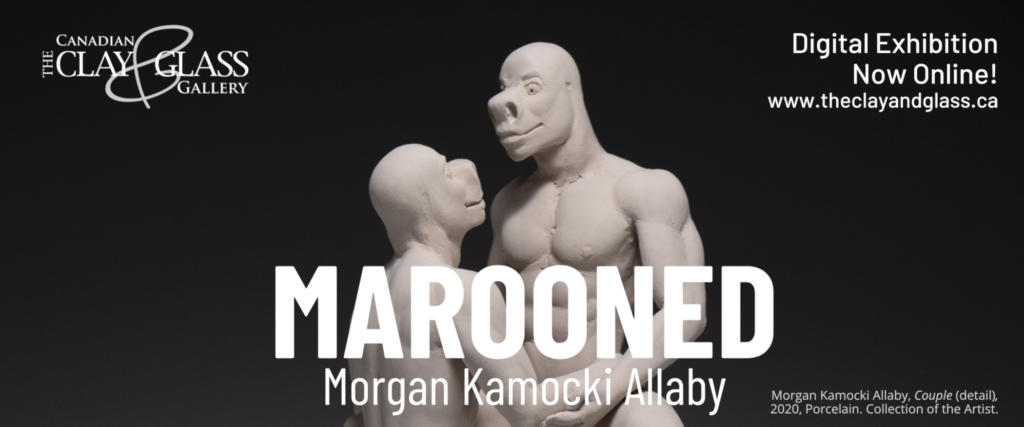
Isolé
Enlacements amoureux, affection passionnée, et tension érotique : Morgan Kamocki Allaby superpose tout ça dans sa plus récente série de sculptures. Avec des couples de figures mâles nues dans des paysages restreints, il pousse les limites de la nudité en art dans une exploration de la sexualité et de l’affection queer. Dans des enlacements amoureux et des poses homoérotiques de domination et de soumission, les figures mettent de l’avant les relations queer dans une affirmation de son intimité. Avec cette série, Kamocki Allaby va à l’encontre de la narration des relations hétéronormatives et le rejet fréquent des relations queer dans la culture et la société.
Bien que les visages d’apparence troublante transmettent des émotions humaines, ils sont des hybrides entre des caractéristiques humaines et animales qui nous attirent. Nous sommes entraînés dans des scènes où les figures partagent des moments intimes, nous découvrons leur affection et leur sexualité. Ces scènes nous défient, mais nous encouragent aussi à découvrir les sentiments physiques et émotionnels présentés dans une déclaration puissante de queerness et de sexualité.
Cette exposition est présentée dans le cadre de la Série des talents émergents et est supportée généreusement par The Musagetes Fund de la Kitchener Waterloo Community Foundation et The C3 Group of Companies.
Loving embraces, passionate affection, and erotic tension. All are aspects of art that involves nudity, a subject that has been popular for centuries. From the marble sculptures of antiquity, to the paintings of the Renaissance, and contemporary photography, nudity has been a core aspect of art that often represents the beauty of the human form and the heroism of important figures. And yet, Morgan Kamocki Allaby’s sculptures bring something new, and perhaps unsettling, to the genre. An upset of traditional norms that is more than welcome.
Through pairs of nude male figures set within a limited landscape, Kamocki Allaby pushes the boundaries of nudity in art through an exploration of queer affection and sexuality. In loving embraces or poses of homoerotic domination and submission, the figures in his new work bring queer relationships front and centre in an affirmation of queer intimacy. Through this series, Kamocki Allaby counters heteronormative narratives of relationships and the frequent dismissal of queer relationships within culture and society.
Although the figures are certainly human and display a range of body types, their faces are designed as a hybrid between human and animal features. It’s this modification to the figures that adds an additional complication to the expected narrative and image at hand. While the faces are capable of human emotion, the viewer’s acknowledgement that they are not in fact human—as well as an inability to identify them as any specific face—results in a dissonance that blurs the identity of the figures. They are at once human, yet not, a modification that both unsettles the viewer and perhaps makes the homoerotic intimacy on display more approachable for some. It is this remodeling of the male nude that demonstrates Kamocki Allaby’s understanding of the politics and ideas at play surrounding his work, as well as his attempts to shift perceptions of the expected in a subtle, yet effective way.
Depiction of queer intimacy in Canadian art, and in ceramics, is arguably a genre still in its infancy. Gaining traction only in the early days of the gay liberation movement in the 1970s, queer intimacy has long been excluded from mainstream arts and culture. Artists of many mediums, including ceramic artists such as Léopold Foulem, Richard Milette, Paul Mathieu, Jeannot Blackburn, and Matthias Ostermann worked in the later years of the twentieth century, and in some cases more recently, to bring queer intimacy, sexuality, and, at times, subcultures of dominance and submission to the forefront of their work. In order to fully express queerness in the public realm, these artists sought to show all facets of these relationships and identities to show a more complete picture than what is often seen. Although categorized by some as “outsider artists”, their work forms a lineage of queer representation and identity that has played a role in developing a mainstream queer acceptance. A lineage that Morgan Kamocki Allaby continues in his work that represents that daily reality of many queer individuals, even at a time in which queer intimacy and narratives can still be ignored, deemed inappropriate, or seen as radical.
In this exhibition, Kamocki Allaby draws upon traditional ceramics, in this case, the porcelain figurines of major production houses like Meissen, while applying his own twist, infusing them with queer intimacy, sexuality, and power dynamics. What might appear at first glance as a simple pair of figures cast in white porcelain as many of us have seen before, reveal themselves to be nude males, isolated within the basic elements of a natural landscape, and arranged in a variety of intimate poses. The tension and intrigue build upon closer inspection, yet the pieces are careful to push the boundaries of this traditional form just enough to convey Kamocki Allaby’s message.
In Couple, Kamocki Allaby’s figures are depicted at their most romantic, as one figure climbs up towards the other, who is seated atop the highest point of their landscape. Their eyes meet as their arms begin to form an embrace. In a simple, quiet moment of intimacy, the figures seem real and honest. They hold an embrace that isn’t strained, but natural and inviting. Idealized male forms cast in pure white porcelain, they retain their subtlety, drawing viewers into an intimate moment of queer affection.
Grapple pushes this concept of queer intimacy and embrace further, bringing with it the homoeroticism of roughhousing or wrestling. As one figure sits on a tree stump, the other is seated below him, held in place by the legs of the other figure in a playful embrace. The lower figure looks up to a pinecone held dangling over his head, taunted by the figure above. Rather than malicious, this playfulness softens the figures’ interaction. A genuine affection can be seen and even felt in their emotions and poses, but Kamocki Allaby heightens the interplay of dominance and submission between the figures as their relationship dynamics play out within the natural landscape.
In a composition reminiscent of Hercules and Cacus by Baccio Bandinelli, a sixteenth century sculpture that conveys the physical strength of Hercules, Kamocki Allaby’s Captive carries with it a slightly different feeling. One figure stands in a pose of physical power, with a rope tied around the neck of the other figure who kneels before him, both facing the viewer. The strength of both figures is readily apparent, even in the figure who is in submission to the one standing over him. As Kamocki Allaby states however, “no conquering has happened here,”i as both figures are content and give a more playful tone than Bandinelli’s sculpture. The figure in the front of the composition has not been defeated as Cacus has, but instead is a prize, and also perhaps a protector, standing guard between the standing figure and the viewer.
In each of these pieces, we are drawn into the barren scenes, feeling close to the figures as we witness the touching and embracing between them. They are scenes of affection, intimacy, and sexuality that reveal themselves slowly, and that challenge us. In their gazes and in their poses, we see human interaction and affection, despite the hybrid faces that look back at us and at each other. These pieces are not loud—they do not demand attention—but rather slowly draw it out from us, engaging us in the layers of feeling, both physical and emotional, that are so candidly on display. Unsettling, for sure, but warm and engaging at the same time, the figures divulge to us desires, intimacy, and beauty in a quiet, yet powerful statement of queerness and sexuality.
Peter Flannery
Curator
i. Correspondence with the artist.






